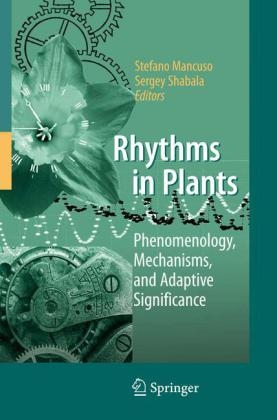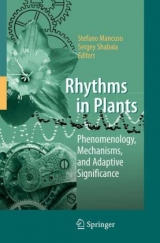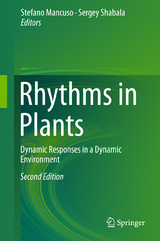Rhythms in Plants
Springer Berlin (Verlag)
978-3-540-68069-7 (ISBN)
- Titel erscheint in neuer Auflage
- Artikel merken
This book reviews recent progress in assessing underlying mechanisms controlling plant circadian and ultradian oscillations, and their physiological implications for growth, development, and adaptive responses to the environment. It focuses on mechanisms and theoretical concepts at the level of the cell to the entire plant. Written by a diverse group of leading researchers, it will surely spark the interest of readers from many branches of science: from physicists and chemists wishing to learn about multi-faceted rhythms in plant biology, to biologists dealing with state-of-the-art modelling of such rhythmic phenomena.
Stefano Mancuso, Professor an der Universität Florenz, leitet das Laboratorio Internazionale di Neurobiologia Vegetale und ist Gründungsmitglied der International Society for Plant Signaling and Behavior. Mit über 250 wissenschaftlichen Publikationen gilt er international als der Spezialist zum Thema. Er sprach 2010 auf der TED-Konferenz, nahm mit Experimenten am europäischen Space Shuttle-Programm teil und stellt auf der EXPO 2015 in Mailand ein neuartiges Pflanzenkultivierungsprojekt vor.
Part 1 Physiological Implications of Oscillatory Processes in Plants 1 Rhythmic Leaf Movements: Physiological and Molecular Aspects Nava Moran Abstract 1.1 Introduction 1.1.1 Historical Perspective 1.1.2 The Types of Leaf Movements 1.2 The Mechanism of Leaf Movement: the Osmotic Motor 1.2.1 Volume Changes 1.2.2 The Ionic Basis for the Osmotic Motor 1.2.3 Plasma Membrane Transporters 1.2.4 Tonoplast Transporters 1.3 Mechanisms of Regulation 1.3.1 Regulation by Protein Modification – Phosphorylation 1.3.2 The Perception of Light 1.3.3 Intermediate Steps 1.3.4 Regulation by Other Effectors 1.4 Unanswered Questions 1.4.1 Acute, Fast Signalling 1.4.2 The Clock Input and Output References 2 The Pollen Tube Oscillator: Integrating Biophysics and Biochemistry into Cellular Growth and Morphogenesis Nuno Moreno, Renato Colaço and José A. Feijó Abstract 2.1 Finding Stability in Instability 2.2 Why Pollen Tubes? 2.3 Growth Oscillations: Trembling with Anticipation? 2.4 Under Pressure 2.5 Another Brick in the Cell Wall 2.6 Cytosolic Approaches to Oscillations: the Ions Within 2.7 On the Outside: Ions and Fluxes 2.8 Actin Cytoskeleton: Pushing it to the Limit 2.9 Membrane Trafficking and Signalling on the Road 2.10 Conclusions References 3 Ultradian Growth Oscillations in Organs: Physiological Signal or Noise? Tobias L. Baskin Abstract 3.1 Introduction 3.1.1 Oscillations as Window into Growth 3.1.2 Growth Versus Movement 3.2 Circumnutation: Growing Around in Circles? 3.3 In Search of Ultradian Growth Oscillations 3.4 The Power of Bending in Plants 3.5 Conclusion andPerspectives References 4 Nutation in Plants Sergio Mugnai, Elisa Azzarello, Elisa Masi, Camilla Pandolfi and Stefano Mancuso Abstract 4.1 Introduction 4.2 Theories and Models for Circumnutation 4.2.1 'Internal Oscillator' Model 4.2.2 'Gravitropic Overshoot' Model 4.2.3 The 'Mediating' Model 4.3 Root Circumnutation References Part 2 Stomata Oscillations 5 Oscillations in Plant Transpiration Anders Johnsson Abstract 5.1 Introduction 5.2 Models for Rhythmic Water Transpiration 5.2.1 Overall Description – 'Lumped' Model 5.2.2 Overall Description – 'Composed' Models 5.2.3 Self-Sustained Guard Cell Oscillations – (Ca2+)cyt Oscillations 5.2.4 Water Channels 5.2.5 Comments on Modelling Transpiration Rhythms 5.3 Basic Experimental Methods Used 5.4 Experimental Findings on Transpiration Oscillations 5.4.1 Occurrence of Transpiration Rhythms: Period of Rhythms 5.4.2 Some Environmental Parameters Influencing Oscillations 5.4.3 Singularities of Transpiration Rhythms: Test of Models 5.5 Ionic Interference with Transpiration Oscillations 5.6 Patchy Water Transpiration from Leaf Surface 5.7 Period Doubling and Bifurcations in Transpiration – a Way to Chaos? 5.8 Conclusions References 6 Membrane Transport and Ca2+ Oscillations in Guard Cells Michael R. Blatt, Carlos Garcia-Mata and Sergei Sokolovski Abstract 6.1 Introduction 6.2 Oscillations and the Membrane Platform 6.3 Elements of Guard Cell Ion Transport 6.4 Ca2+ and Voltage 6.4.1 The Ca2+ Theme 6.4.2 [Ca2+]i Oscillations 6.4.3 Voltage Oscillations 6.4.4 Membrane Voltage and the '[Ca2+]i Cassette' 6.5 Concluding
| Sprache | englisch |
|---|---|
| Maße | 155 x 235 mm |
| Gewicht | 775 g |
| Einbandart | gebunden |
| Themenwelt | Naturwissenschaften ► Biologie ► Botanik |
| Naturwissenschaften ► Biologie ► Zellbiologie | |
| Schlagworte | Calcium • Cells • Expression • gene expression • Innere Uhr • Internal clock • Molecular Biology • Morphogenesis • oscillations • Oszillationen • Pflanzen • Pflanzenphysiologie • plants • Rhythmen • Rhythms • Transport • Transporter |
| ISBN-10 | 3-540-68069-1 / 3540680691 |
| ISBN-13 | 978-3-540-68069-7 / 9783540680697 |
| Zustand | Neuware |
| Informationen gemäß Produktsicherheitsverordnung (GPSR) | |
| Haben Sie eine Frage zum Produkt? |
aus dem Bereich





